Split Ring Resonator-Based Bandstop Filter for Improving Isolation in Compact MIMO Antenna
Abstract
1. Introduction
2. Antenna Configuration and Design Process
2.1. Basic MIMO Antenna Design
2.2. SRR-Based Bandstop Filter Design
2.3. MIMO Antenna with SRR-Based Bandstop Filter
2.4. Stub Matching Network for MIMO Antenna
3. Results and Discussion
3.1. S Parameters
3.2. Gain, Efficiency, and Radiation Patterns
3.3. Diversity Characteristics
4. Comparative Analysis
5. Conclusions
Author Contributions
Funding
Institutional Review Board Statement
Informed Consent Statement
Data Availability Statement
Acknowledgments
Conflicts of Interest
References
- Chen, S.-C.; Wang, Y.-S.; Chung, S.-J. A decoupling technique for increasing the port isolation between two strongly coupled antennas. IEEE Trans. Antennas Propag. 2008, 56, 3650–3658. [Google Scholar] [CrossRef]
- Chen, X.; Zhang, S.; Li, Q. A review of mutual coupling in MIMO systems. IEEE Access 2018, 6, 24706–24719. [Google Scholar] [CrossRef]
- Zhao, L.; Wu, K.-L. A dual-band coupled resonator decoupling network for two coupled antennas. IEEE Trans. Antennas Propag. 2015, 63, 2843–2850. [Google Scholar] [CrossRef]
- Thummaluru, S.R.; Kumar, R.; Chaudhary, R.K. Isolation and frequency reconfigurable compact MIMO antenna for wireless local area network applications. IET Microw. Antennas Propag. 2019, 13, 519–525. [Google Scholar] [CrossRef]
- Zhang, Y.-M.; Zhang, S.; Li, J.-L.; Pedersen, G.F. A transmission line-based decoupling method for MIMO antenna arrays. IEEE Trans. Antennas Propag. 2019, 67, 3117–3131. [Google Scholar] [CrossRef]
- Zhao, L.; Wu, K.-L. A decoupling technique for four-element symmetric arrays with reactively loaded dummy elements. IEEE Trans. Antennas Propag. 2014, 62, 4416–4421. [Google Scholar] [CrossRef]
- Zhang, S.; Pedersen, G.F. Mutual coupling reduction for UWB MIMO antennas with a wideband neutralization line. IEEE Antennas Wirel. Propag. Lett. 2015, 15, 166–169. [Google Scholar] [CrossRef]
- Li, Z.; Du, Z.; Takahashi, M.; Saito, K.; Ito, K. Reducing mutual coupling of MIMO antennas with parasitic elements for mobile terminals. IEEE Trans. Antennas Propag. 2011, 60, 473–481. [Google Scholar] [CrossRef]
- Zhang, K.; Soh, P.J.; Yan, S. Meta-Wearable Antennas—A Review of Metamaterial Based Antennas in Wireless Body Area Networks. Materials 2021, 14, 149. [Google Scholar] [CrossRef] [PubMed]
- Ali, T.; Aw, M.S.; Biradar, R.C. A Compact Bandwidth Enhanced Antenna Loaded with SRR For WLAN/WiMAX/Satellite Applications. Adv. Electromagn. 2018, 7, 78–84. [Google Scholar] [CrossRef]
- Xu, J.; Tao, L.; Zhang, R.; Hao, Y.; Huang, S.; Bi, K. Broadband complementary ring-resonator based terahertz antenna. Opt. Express 2017, 25, 17099–17104. [Google Scholar] [CrossRef]
- Bhattacharyya, S.; Ghosh, S.; Srivastava, K.V. Bandwidth-Enhanced Metamaterial Absorber Using Electric Field–Driven Lc Resonator for Airborne Radar Applications. Microw. Opt. Technol. Lett. 2013, 55, 2131–2137. [Google Scholar] [CrossRef]
- Xu, J.; Bi, K.; Zhang, R.; Hao, Y.; Lan, C.; McDonald-Maier, K.D.; Zhai, X.; Zhang, Z.; Huang, A.S. A small-divergence-angle orbital angular momentum metasurface antenna. Research 2019, 2019, 9686213. [Google Scholar] [CrossRef]
- Zhang, J.; Yan, S.; Vandenbosch, G.A. Metamaterial-inspired dual-band frequency-reconfigurable antenna with pattern diversity. Electron. Lett. 2019, 55, 573–574. [Google Scholar] [CrossRef]
- Panda, A.K.; Sahu, S.; Mishra, R.K. A compact dual-band 2 × 1 metamaterial inspired MIMO antenna system with high port isolation for LTE and WiMax applications. Int. J. RF Microw. Comput. Aided Eng. 2017, 27, e21122. [Google Scholar] [CrossRef]
- Zhai, G.; Chen, Z.N.; Qing, X. Enhanced isolation of a closely spaced four-element MIMO antenna system using metamaterial mushroom. IEEE Trans. Antennas Propag. 2015, 63, 3362–3370. [Google Scholar] [CrossRef]
- Lee, J.-Y.; Kim, S.-H.; Jang, J.-H. Reduction of mutual coupling in planar multiple antenna by using 1-D EBG and SRR structures. IEEE Trans. Antennas Propag. 2015, 63, 4194–4198. [Google Scholar] [CrossRef]
- Li, M.; Zhong, B.G.; Cheung, S. Isolation enhancement for MIMO patch antennas using near-field resonators as coupling-mode transducers. IEEE Trans. Antennas Propag. 2018, 67, 755–764. [Google Scholar] [CrossRef]
- Wang, C.; Yang, X.-S.; Wang, B.-Z. A metamaterial-based compact broadband planar monopole MIMO antenna with high isolation. Microw. Opt. Technol. Lett. 2020, 62, 2965–2970. [Google Scholar] [CrossRef]
- Garg, P.; Jain, P. Isolation improvement of MIMO antenna using a novel flower shaped metamaterial absorber at 5.5 GHz WiMAX band. IEEE Trans. Circuits Syst. II Express Briefs 2019, 67, 675–679. [Google Scholar] [CrossRef]
- Park, J.; Choi, J.; Park, J.-Y.; Kim, Y.-S. Study of a T-shaped slot with a capacitor for high isolation between MIMO antennas. IEEE Antennas Wirel. Propag. Lett. 2012, 11, 1541–1544. [Google Scholar] [CrossRef]
- Wang, L.; Du, Z.; Yang, H.; Ma, R.; Zhao, Y.; Cui, X.; Xi, X. Compact UWB MIMO antenna with high isolation using fence-type decoupling structure. IEEE Antennas Wirel. Propag. Lett. 2019, 18, 1641–1645. [Google Scholar] [CrossRef]
- Han, M.-S.; Choi, J. Multiband MIMO antenna with a band stop filter for high isolation characteristics. In Proceedings of the 2009 IEEE Antennas and Propagation Society International Symposium, North Charleston, SC, USA, 1–5 June 2009. [Google Scholar]
- Thummaluru, S.; Chaudhary, R. Mu-negative metamaterial filter based isolation technique for MIMO antennas. Electron. Lett. 2017, 53, 644–646. [Google Scholar] [CrossRef]
- Chen, X.; Grzegorczyk, T.M.; Wu, B.-I.; Pacheco, J., Jr.; Kong, J.A. Robust method to retrieve the constitutive effective parameters of metamaterials. Phys. Rev. E 2004, 70, 016608. [Google Scholar] [CrossRef]
- Blanch, S.; Romeu, J.; Corbella, I. Exact representation of antenna system diversity performance from input parameter description. Electron. Lett. 2003, 39, 705–707. [Google Scholar] [CrossRef]
- Saadh, A.M.; Ashwath, K.; Ramaswamy, P.; Ali, T.; Anguera, J. A uniquely shaped MIMO antenna on FR4 material to enhance isolation and bandwidth for wireless applications. Aeu-Int. J. Electron. Commun. 2020, 123, 153316. [Google Scholar] [CrossRef]
- Sharawi, M.S. Printed MIMO Antenna Systems: Performance Metrics, Implementations and Challenges. Available online: https://www.e-fermat.org/files/articles/15337272d22a9a.pdf (accessed on 6 March 2021).
- Kumari, T.; Das, G.; Sharma, A.; Gangwar, R.K. Design approach for dual element hybrid MIMO antenna arrangement for wideband applications. Int. J. Rf Microw. Comput. Aided Eng. 2019, 29, e21486. [Google Scholar] [CrossRef]
- Das, G.; Sharma, A.; Gangwar, R.K. Dielectric resonator based circularly polarized MIMO antenna with polarization diversity. Microw. Opt. Technol. Lett. 2018, 60, 685–693. [Google Scholar] [CrossRef]
- Sarkar, G.A.; Ballav, S.; Chatterjee, A.; Ranjit, S.; Parui, S.K. Four element MIMO DRA with high isolation for WLAN applications. Prog. Electromagn. Res. 2019, 84, 99–106. [Google Scholar] [CrossRef]

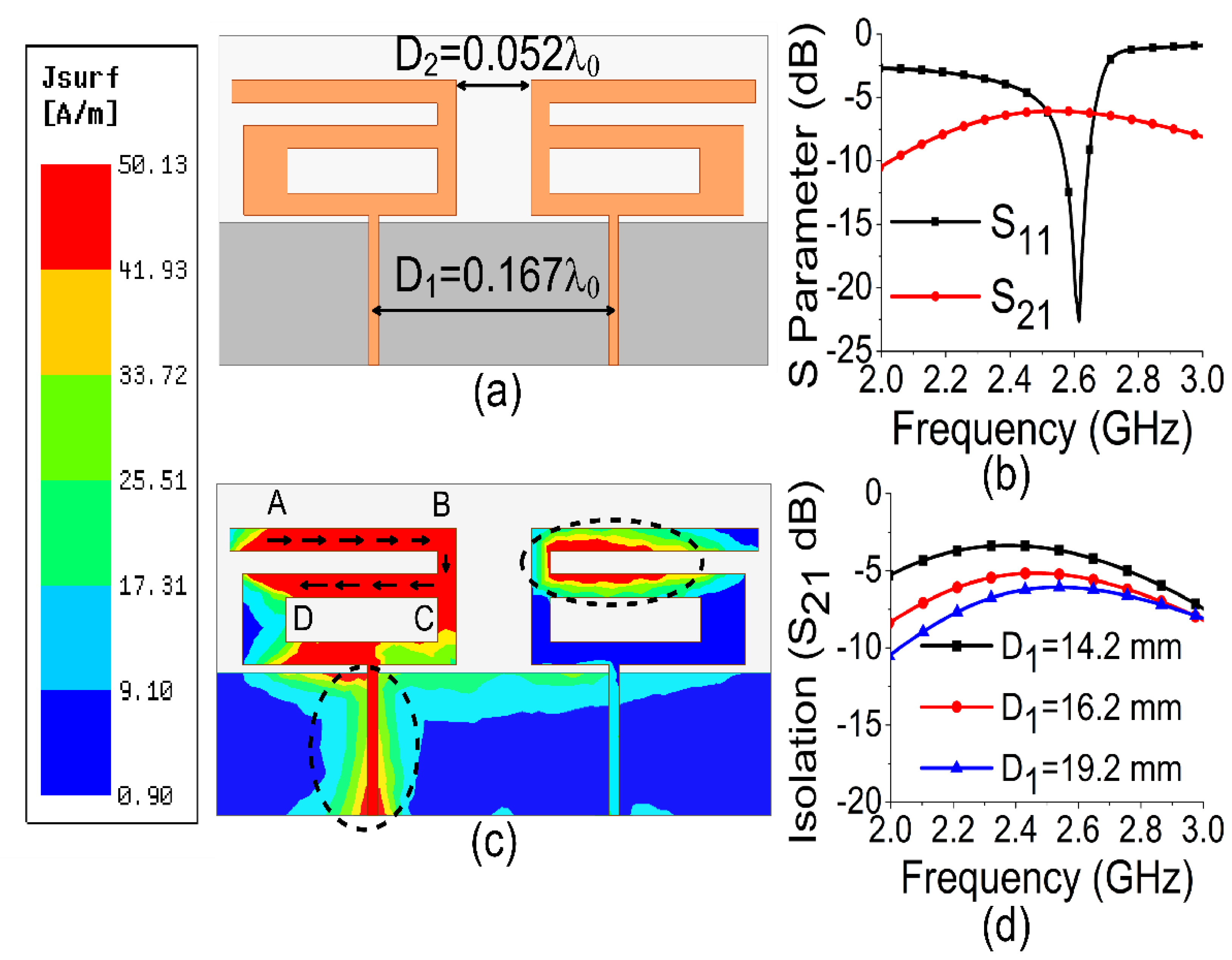



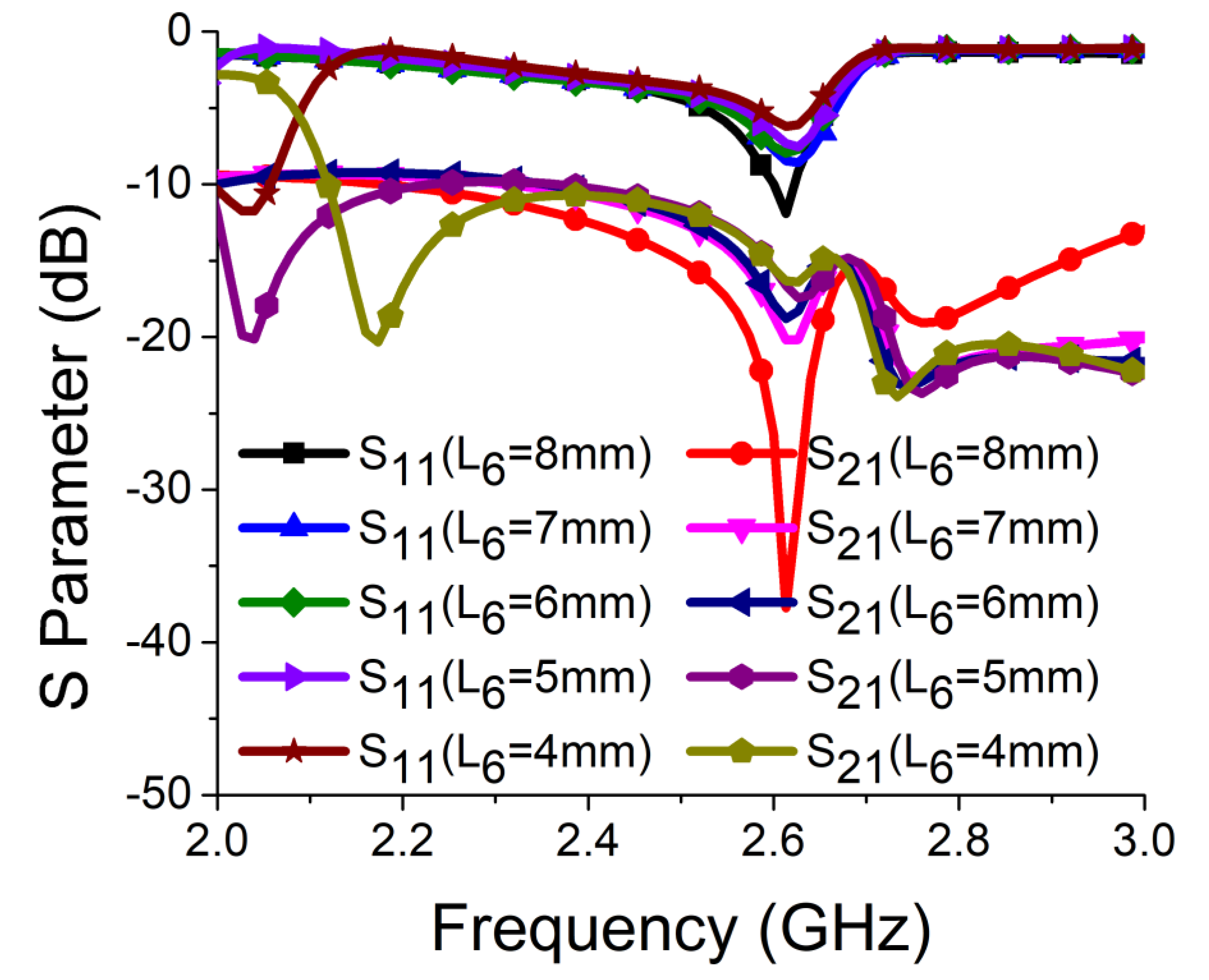
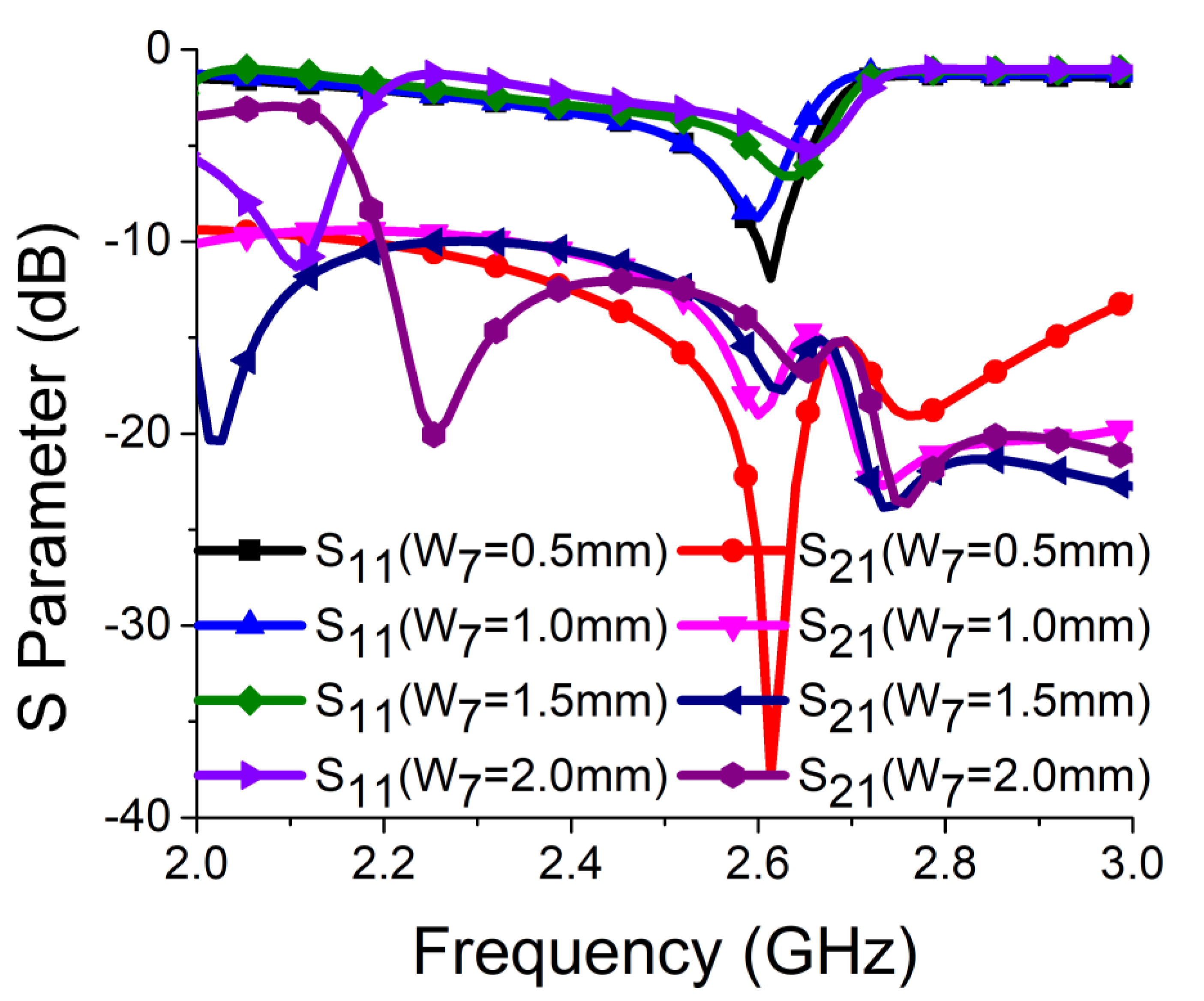



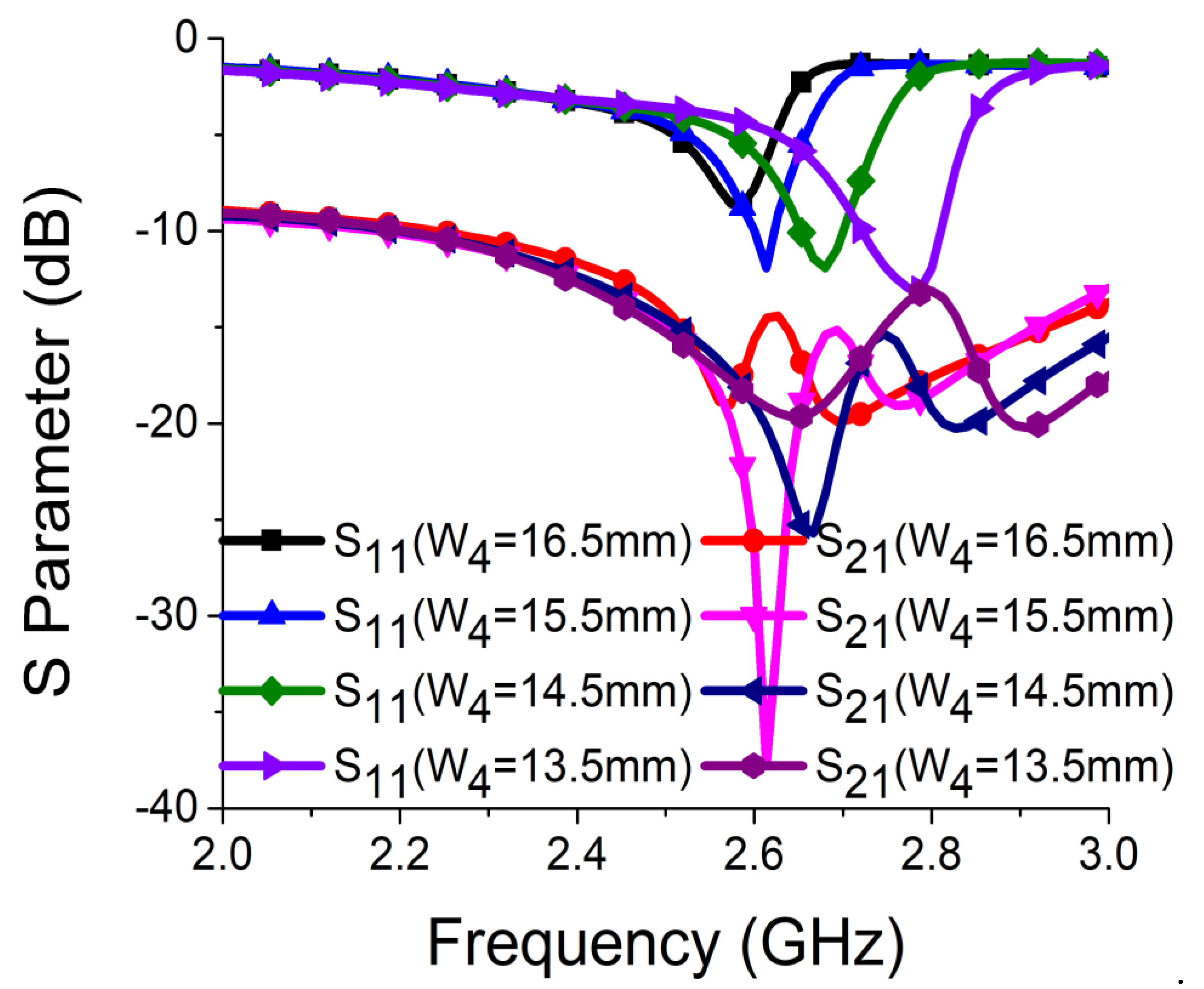
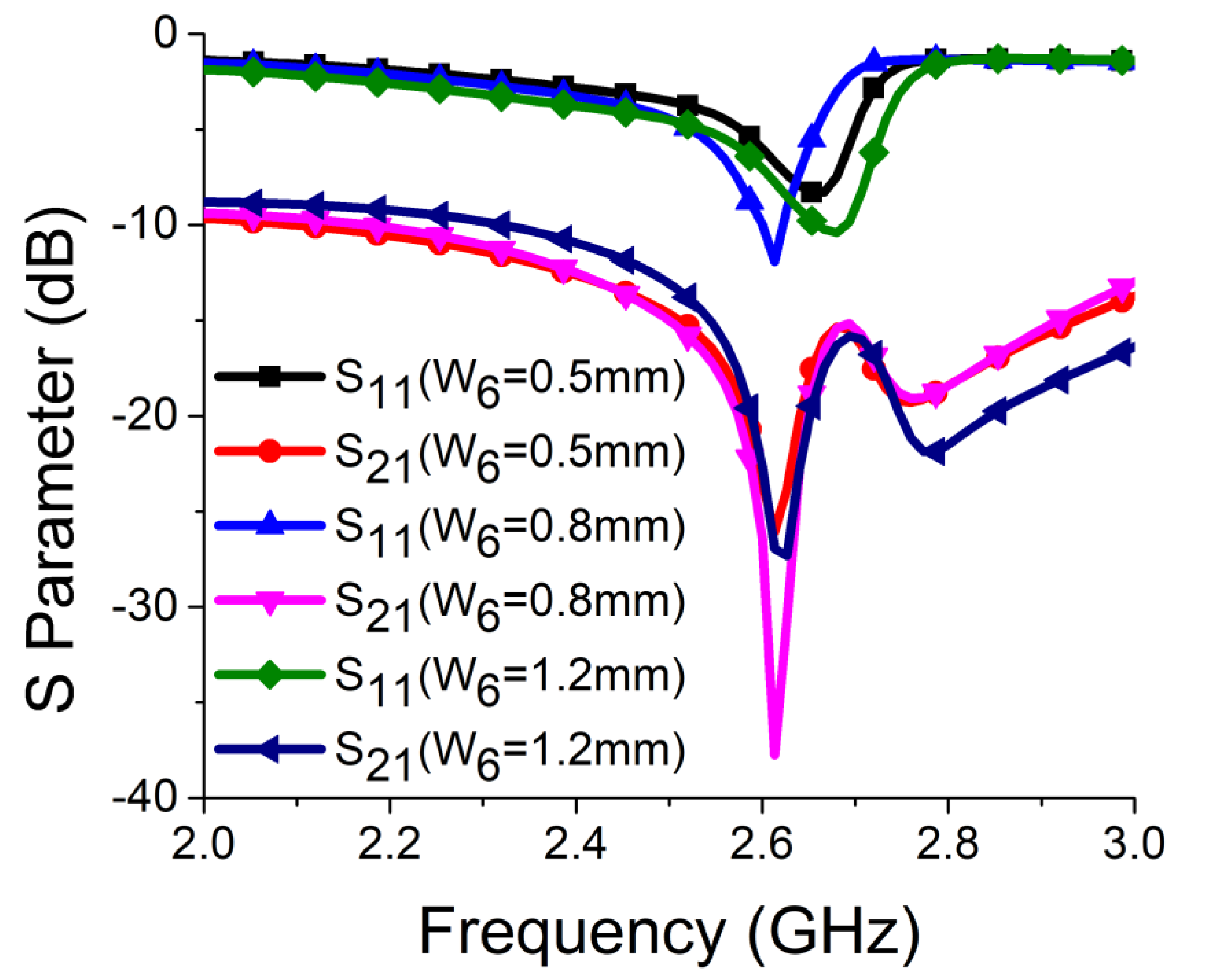

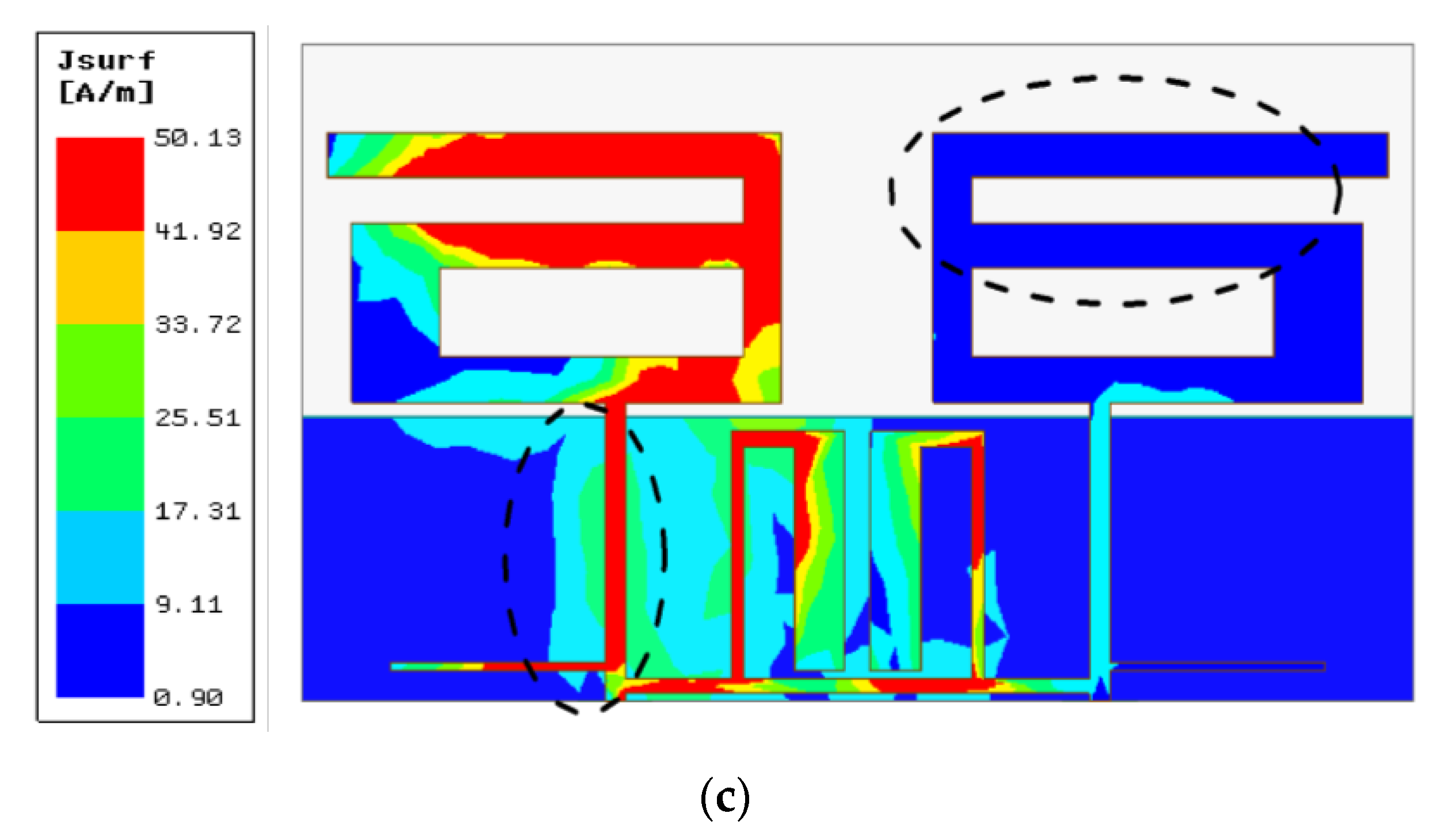
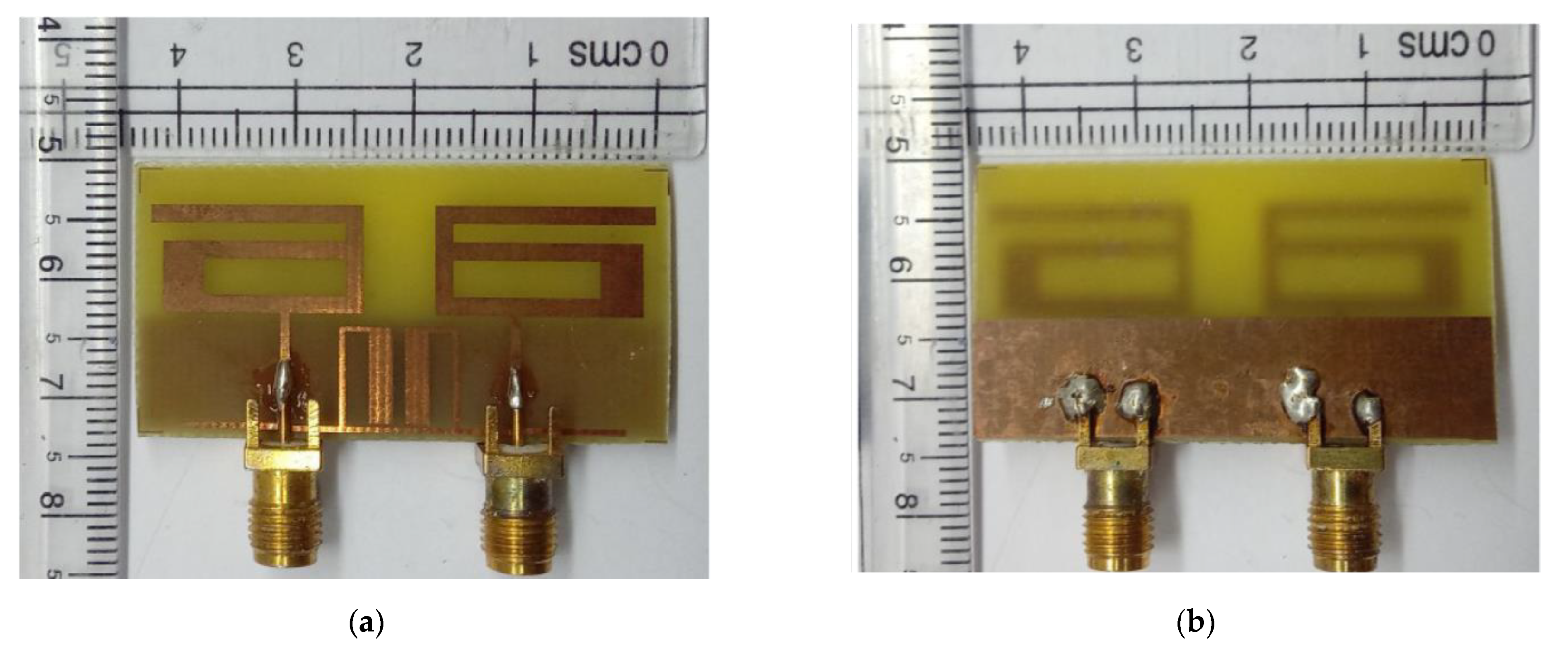


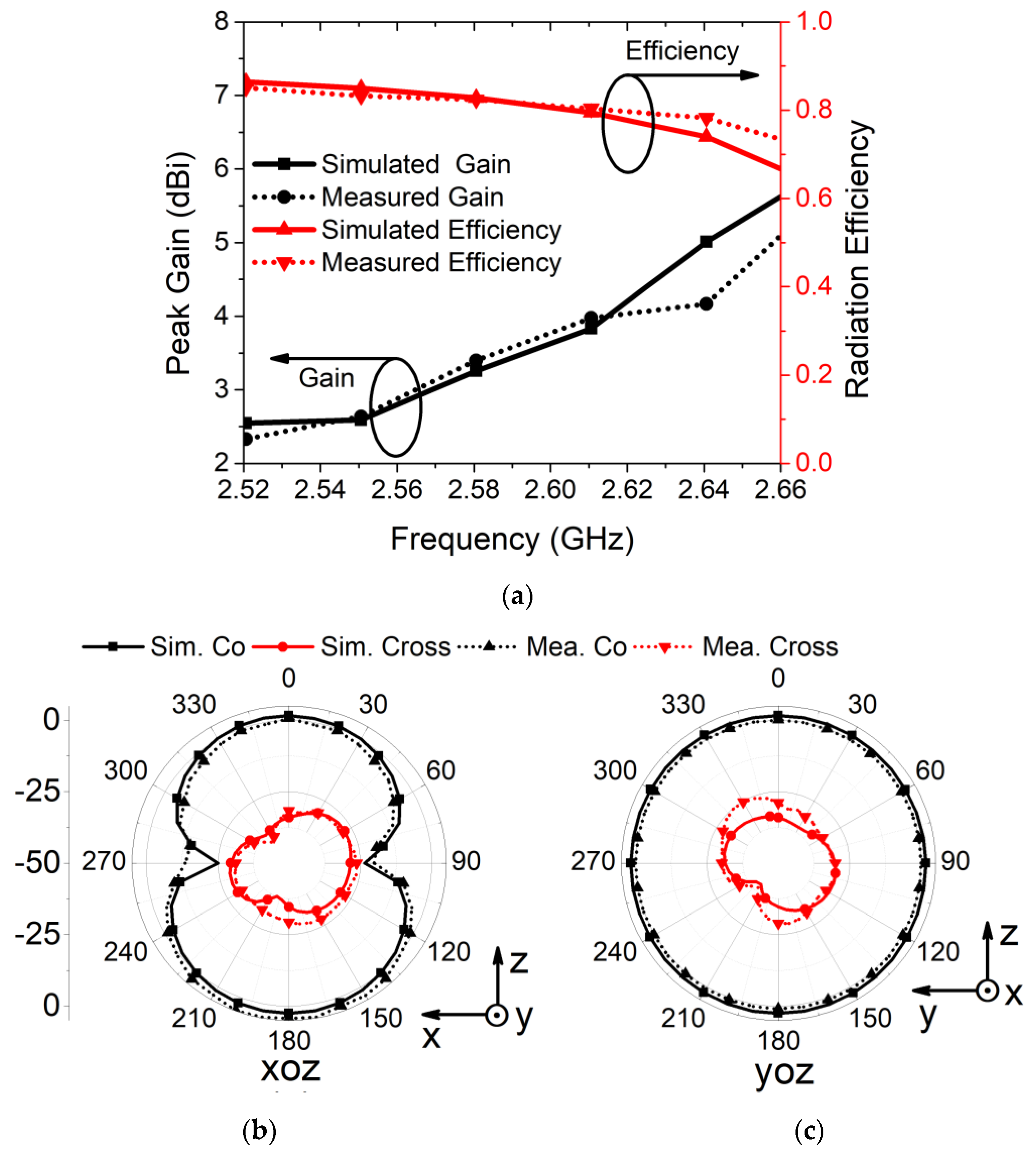
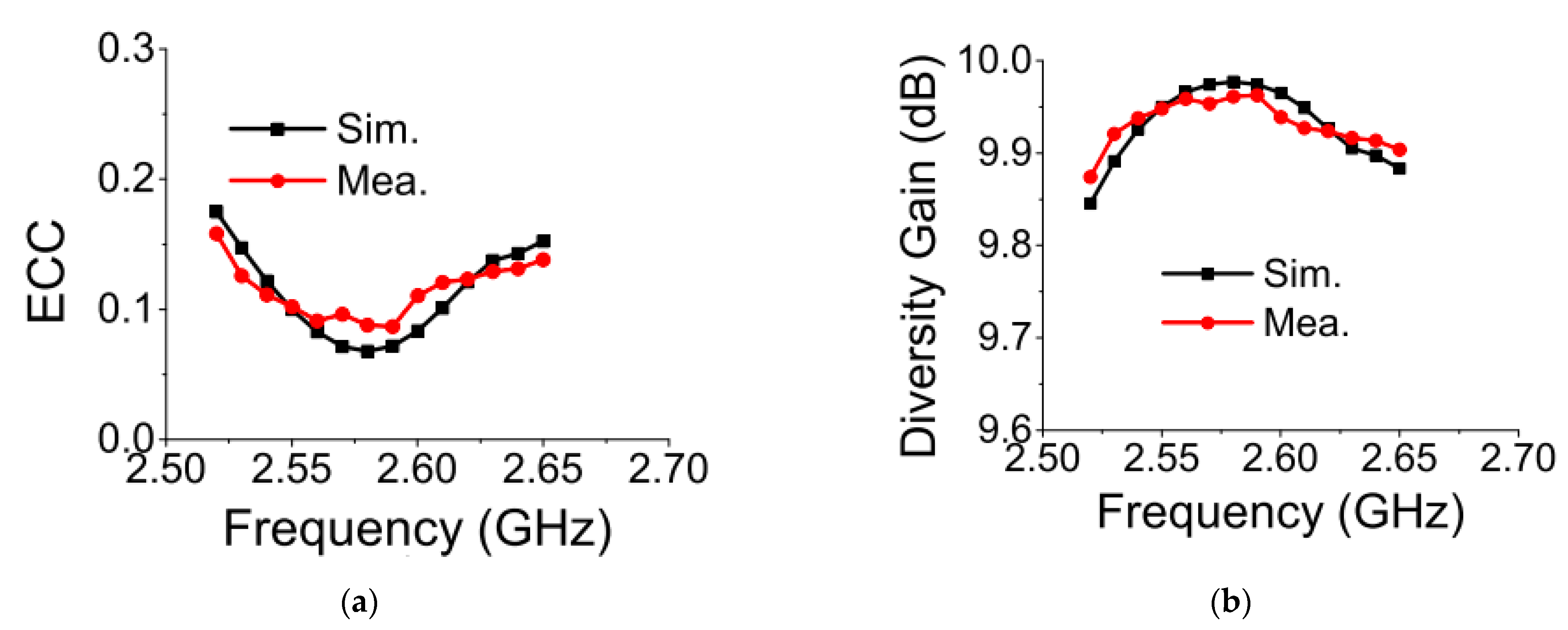

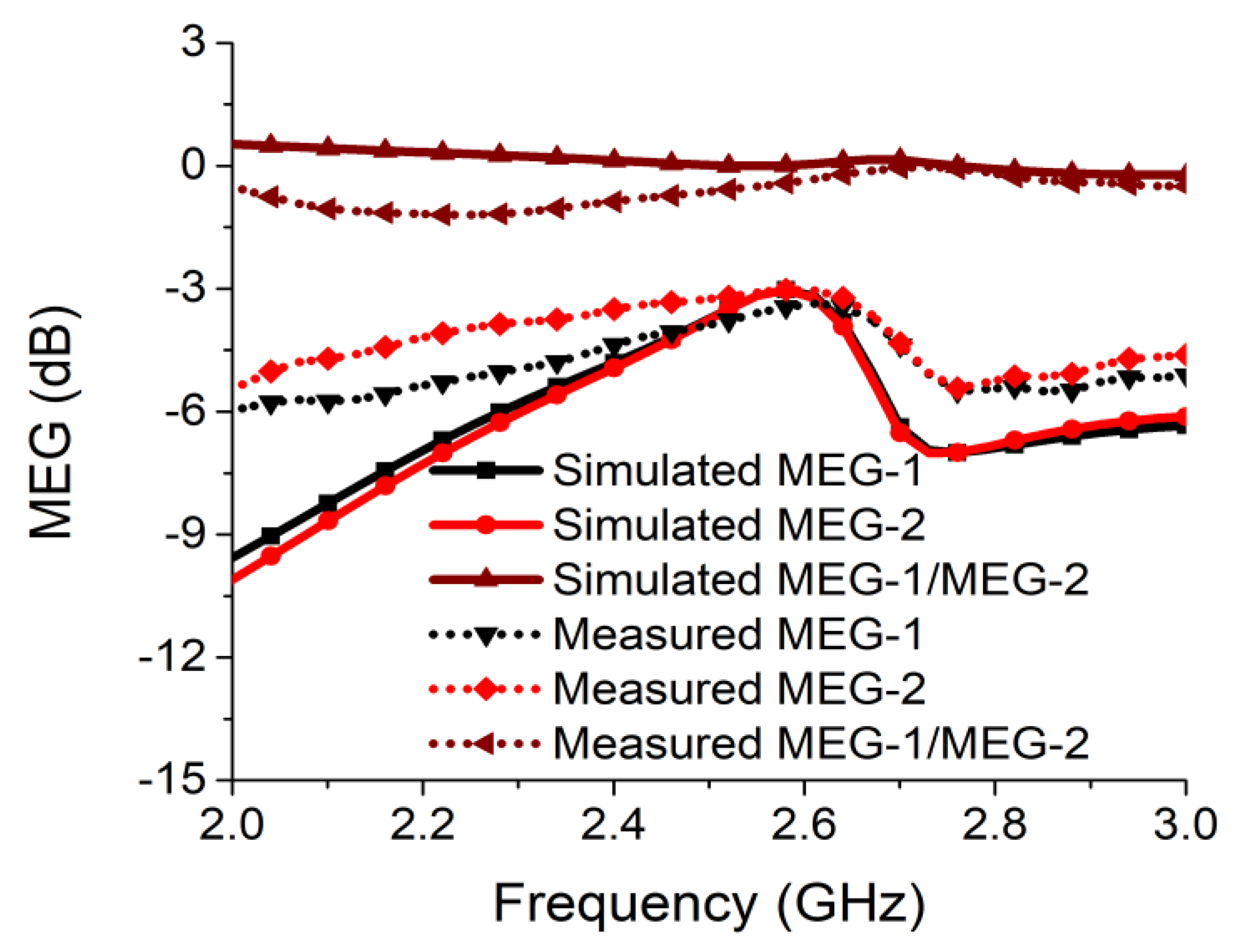

| Ref. | Decoupling Technique | Dimension | Resonating Frequency (GHz) | Isolation (dB) | Gain (dBi) | ECC |
|---|---|---|---|---|---|---|
| [8] | Parasitic Elements | 0.042 × 0.66 | 2.1 | 25 | – | – |
| [22] | Band Stop Filter (BSF) | 0.53 × 0.37 | 3–11 | >25 | >3 | <0.004 |
| [23] | BSF | 0.09 × 0.03 | 0.71, 1.92, 2.55 | 24, 22, 13 | −7.5, 3.5, 4.2 | – |
| [24] | Metamaterial (MTM) BSF | 45.5 × 45.5 | 2.67 | 35 | – | <0.01 |
| [19] | MTM | 0.41 × 0.41 | 3.5 | 28 | 3.2 | <0.05 |
| [20] | MTM Absorber | 1.30 × 0.77 | 5.5 | 43.71 | 6.28 | <0.05 |
| Prop. work | Split Ring Resonator (SRR) BSF | 0.38 × 0.19 | 2.61 | 38 | 3.8 | <0.121 |
Publisher’s Note: MDPI stays neutral with regard to jurisdictional claims in published maps and institutional affiliations. |
© 2021 by the authors. Licensee MDPI, Basel, Switzerland. This article is an open access article distributed under the terms and conditions of the Creative Commons Attribution (CC BY) license (http://creativecommons.org/licenses/by/4.0/).
Share and Cite
Islam, H.; Das, S.; Ali, T.; Kumar, P.; Dhar, S.; Bose, T. Split Ring Resonator-Based Bandstop Filter for Improving Isolation in Compact MIMO Antenna. Sensors 2021, 21, 2256. https://doi.org/10.3390/s21072256
Islam H, Das S, Ali T, Kumar P, Dhar S, Bose T. Split Ring Resonator-Based Bandstop Filter for Improving Isolation in Compact MIMO Antenna. Sensors. 2021; 21(7):2256. https://doi.org/10.3390/s21072256
Chicago/Turabian StyleIslam, Hashinur, Saumya Das, Tanweer Ali, Pradeep Kumar, Sourav Dhar, and Tanushree Bose. 2021. "Split Ring Resonator-Based Bandstop Filter for Improving Isolation in Compact MIMO Antenna" Sensors 21, no. 7: 2256. https://doi.org/10.3390/s21072256
APA StyleIslam, H., Das, S., Ali, T., Kumar, P., Dhar, S., & Bose, T. (2021). Split Ring Resonator-Based Bandstop Filter for Improving Isolation in Compact MIMO Antenna. Sensors, 21(7), 2256. https://doi.org/10.3390/s21072256








